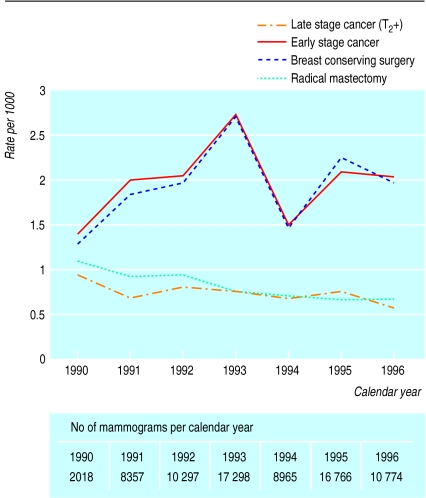In the recent Cochrane review of mammographic screening the authors and editors disagreed with respect to reporting the effect of screening on rates of aggressive treatment for breast cancer.1 The authors maintained that screening increased the number of mastectomies by around 20%, mainly as a result of overdiagnosis. If this were the case, populations in which screening has been introduced should see a subsequent increase in the number of radical treatments for breast cancer and an increase in the incidence of breast cancer in excess of that expected purely from lead time. We report the changes in rates of radical surgery and incidence of breast cancer since the introduction of the Florence mammographic screening programme.
Methods and results
We studied the period from 1990 to 1996. During this time 59 947 women aged 50-69 years were invited to a prevalence screen and to subsequent screens at two year intervals (2.4 years in practice).2 At the beginning of 1990 no women had been invited; by the end of 1994 all the women had been invited to at least one screen. Attendance rates averaged 60%. We considered cases of breast cancer with pathological size T2 or greater to be late stage. Early stage cases included tumours of less than 2 cm size and in situ carcinomas.
We plotted absolute rates of mastectomy and breast conserving surgery—defined as lumpectomy, wide excision, and quadrantectomy—per thousand women in the population (not per cancer case) against time for the years 1990-6. We assessed the significance of changes over time by trend tests in Poisson regression.
The figure shows the absolute rates of mastectomy and breast conserving surgery over time, with the disease incidence by stage. Rates of breast conserving surgery increased by around 0.7 per thousand (P=0.01) over the period 1990-6, and rates of radical surgery declined by 0.5 per thousand (P<0.001). These rates closely paralleled those of early and late stage breast cancer. Early disease and breast conserving surgery peaked in 1993 as the mobile screening units completed the prevalence screen; this was followed by a reduction in 1994 after the prevalence screen had finished, as one would expect.3 The rates were also strongly related to the amount of screening activity. The peak number of mammograms was 17 298 in 1993, followed by only 8965 in 1994 when the prevalence screen was largely completed but the first repeat screen only just beginning. In 1990 the rate of mastectomy was 1.08 (95% confidence interval 0.84 to 1.37) per thousand, whereas in 1996 it was 0.62 (0.44 to 0.86) per thousand. The rates of breast conserving surgery were 1.18 (0.92 to 1.48) per thousand in 1990 and 1.87 (1.54 to 2.21) per thousand in 1996.
Comment
The rate of breast conserving surgery has increased significantly with the advent of screening, and the rate of radical surgery has declined significantly. Similar reductions in mastectomy rates have been observed elsewhere.4 This indicates that the introduction of screening brings about a reduction in mastectomy rates, not an increase. Follow up will continue to ascertain whether these findings are maintained.
Figure.
Size of breast cancers and type of operation
Footnotes
Funding: EP was supported by an American Cancer Society grant. The Florence City Programme is supported as a member of the European Breast Cancer Screening Network.
Competing interests: None declared.
References
- 1.Olsen O, Gotzsche PC. Cochrane review on screening for breast cancer with mammography. Lancet. 2001;358:1340–1342. doi: 10.1016/S0140-6736(01)06449-2. [DOI] [PubMed] [Google Scholar]
- 2.Paci E, Duffy SW, Giorgi D, Prevost TC, Rosselli del Turco M. Population-based breast cancer screening programmes: estimates of sensitivity, overdiagnosis and early prediction of the benefit. In: Duffy SW, Hill C, Esteve J, editors. Quantitative methods for the evaluation of cancer screening. London: Arnold; 2001. [Google Scholar]
- 3.Day NE, Walter SD. Simplified models of screening for chronic disease: estimation procedures from mass screening programmes. Biometrics. 1984;43:1–13. [PubMed] [Google Scholar]
- 4.Wingo PA, Guest JL, McGinnis L, Miller DS, Rodriguez C, Cardinez CJ, et al. Patterns of inpatient surgeries for the top four cancers in the United States, National Hospital Discharge Survey, 1988-95. Cancer Causes Control. 2000;11:497–512. doi: 10.1023/a:1008944209648. [DOI] [PubMed] [Google Scholar]



